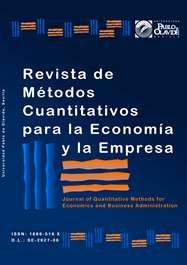Application of the purchasing power parity hypothesis in the forecast of the exchange rate of the Colombian peso against the US dollar
DOI:
https://doi.org/10.46661/revmetodoscuanteconempresa.4476Keywords:
forecast, Colombian peso, WTI Oil, VEC Models, parityAbstract
This paper shows the forecast of the exchange rate between the Colombian peso and the US dollar (hereinafter the dollar) from December 2019 to December 2020, based on a VEC (Vector error correction) model based on the parity hypothesis of weak purchasing power. With this, it´s proposed that the exchange rate is adjusted not only to balance the differences in rates between the United States and Colombia, but also to balance a third variable, in this case WTI crude oil price. Caused by that the main source of export earnings for Colombia has its source in oil resources, it was considered valuable to use WTI quotes as a proxy to estimate the likely direction of the exchange rate in the short and medium term.
Downloads
References
Akaike, H. (1974). A new look at the statistical model identification. IEEE Transactions on Automatic Control, 19(6), 716-723. https://doi.org/10.1109/TAC.1974.1100705
Amuzegar, J. (1978). OPEC and the Dollar Dilemma. Foreign Affairs, 56(4), 740-750.
Banco de la República de Colombia (2019, Diciembre 13). banrep.gov.co. Retrieved from https://www.banrep.gov.co/es/estadisticas/trm
Cerquera, O.H., Gómez, C.F., & Arias, C. J. (2018). Purchasing power parity in the Colombian exchange rate. Ánfora, 25(45), 123-143. https://doi.org/10.30854/anf.v25.n45.2018.515.
Cochrane, S., & DeFina, R. (1995). Predictable components in exchange rates. Quarterly Review of Economics and Finance, 35(1), 1-14.
Cumby, R., & Obstfeld, M. (1984). International interest rate and price level linkage under flexible exchange rates: review of recent evidence. In R. M. Bilson, Exchange Rate Theory and Practice (pp. 121-151). Chicago, Estados Unidos: University of Chicago Press.
DANE (2019, agosto). DANE. Retrieved from https://www.dane.gov.co/index.php/estadisticas-por-tema/comercio-internacional/exportaciones
Engle, R.F., & Granger, C. (1987). Co-integration and error correction: representation, estimation, and testing. Econometrica, 55(2), 251-267.
Federal Reserve Bank of St Louis (2019). fred.stlouisfed.org. Retrieved from https://fred.stlouisfed.org/series/TWEXB
Frenkel, J.A. (1981). Flexible Exchange Rates, Prices, and the Role of News: Lessons from the 1970s. Journal of Political Economy, 89(4), 665-705.
Garín, J., Lester, R., & Sims, E. (2018). Intermediate Macroeconomics. Indiana: University of Notre Dame.
Granger, C.W. (1969). Investigating Causal Relations by Econometric Models and Cross-spectral Methods. Econometrica, 424-438.
Gregorio, J.D. (2012). POLICY CORNER: Commodity Prices, Monetary Policy, and Inflation. IMF Economic Review, 60, 600-633. https://doi.org/10.1057/imfer.2012.15
Hernández, C.F., Mesa, R.F., & Pareja, I.V. (2009). Proyección de la tasa de cambio de Colombia bajo condiciones de PPA: evidencia empírica usando var. Estudios Gerenciales, 25(113), 211-226.
Holmes, M., & Wang, P. (2005). Do African countries move asymmetrically towards Purchasing Power Parity? South African Journal of Economics, 73(2), 292-301. https://doi.org/10.1111/j.1813-6982.2005.00018.x
Jacobson, T., & Nessen, M. (2004). Examining world-wide Purchasing Power Parity. Empirical Economics, 29, 463-476. https://doi.org/10.1007/s00181-003-0176-2
Johansen, S. (1988). Statistical analysis of cointegration vectors. Journal of Economic Dynamics and Control, 231-254. https://doi.org/10.1016/0165-1889(88)90041-3
Johansen, S., & Juselius, K. (1990). Maximum likelihood estimation and inference on cointegration - with applications to the demand for money. Oxford Bulletin of Economics and Statistics, 52(2), 169-210. https://doi.org/10.1111/j.1468-0084.1990.mp52002003.x
Kim, Y. (1990). Purchasing power parity: another look at the long-run data. Economics Letters, 32(4), 339-344. DOI: https://doi.org/10.1016/0165-1765(90)90026-W
Krugman, P. (1978). Purchasing power parity and exchange rates. Journal of International Economics, 8(3), 397-407. DOI: https://doi.org/10.1016/0022-1996(78)90003-X
Kugler, P., & Lenz, C. (1993). Multivariate Cointegration Analysis and the Long-Run Validity of PPP. The Review of Economics and Statistics, 75(1), 180-184. https://doi.org/10.2307/2109645
Lipschitz, L., & Schadler, S. (2019). Macroeconomics for Professionals: A guide for analysts and those who need to understand them. Cambridge, United Kingdom: Cambridge University Press.
Macdonald, R. (1993). The monetary approach to the exchange rate: rational expectations, long-run equilibrium, and forecasting. IMF Staff Papers, 92(34), 89-107.
Mankiw, N.G. (2016). Macroeconomics. Nueva York: Worth Publishers, Macmillan.
Papell, D., & Podran, R. (2006). Additional Evidence of Long-Run Purchasing Power Parity with Restricted Structural Change. Journal of Money, Credit, and Banking, 38(5), 1329-1349. https://doi.org/10.1353/mcb.2006.0073.
Patel, J. (1990). Purchasing power parity as a long run relation. Journal of Applied Econometrics, 5(4), 367-379. https://doi.org/10.1002/jae.3950050405.
Serletis, A., & Gogas, P. (2004). Long-horizon regression tests of the theory of purchasing power parity. Journal of Banking & Finance, 28(8), 1961-1985. https://doi.org/10.1016/j.jbankfin.2003.07.006.
Taylor, M. (1988). An empirical examination of long-run purchasing power parity using cointegration techniques. Applied Economics, 20(10), 1369-1381. https://doi.org/10.1080/00036848800000107.
Urrutia, M., & Llano, J. (2012). Los actores en la crisis económica de fin de siglo. Bogotá: Ediciones Uniandes.
Varian, H. (1992). Microeconomic analysis. New York: W.W. Norton & Company, Inc.
Wang, P. (2009). The Economics of Foreign Exchange and Global Finance. Berlín, Alemania: Springer.
Downloads
Published
How to Cite
Issue
Section
License

This work is licensed under a Creative Commons Attribution-ShareAlike 4.0 International License.
Submission of manuscripts implies that the work described has not been published before (except in the form of an abstract or as part of thesis), that it is not under consideration for publication elsewhere and that, in case of acceptance, the authors agree to automatic transfer of the copyright to the Journal for its publication and dissemination. Authors retain the authors' right to use and share the article according to a personal or instutional use or scholarly sharing purposes; in addition, they retain patent, trademark and other intellectual property rights (including research data).
All the articles are published in the Journal under the Creative Commons license CC-BY-SA (Attribution-ShareAlike). It is allowed a commercial use of the work (always including the author attribution) and other derivative works, which must be released under the same license as the original work.
Up to Volume 21, this Journal has been licensing the articles under the Creative Commons license CC-BY-SA 3.0 ES. Starting from Volume 22, the Creative Commons license CC-BY-SA 4.0 is used.










